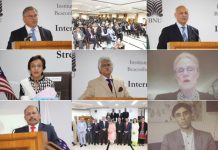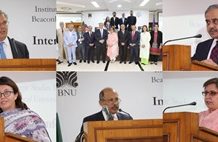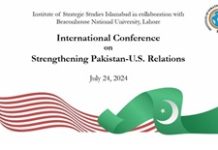Outside of South Asia, Indian Prime Minister Narendra Modi, made his first foreign trip to Japan, a five-day visit on 30 August- 4 September. Japanese Prime Minister Shinzo Abe, a lover of India, welcomed Modi. Oddly, the visit was started from Osaka and then to the ancient capital of Kyoto.
Both countries have been trying to ink a civil nuclear deal delayed by some preconditions and the crippled Fukushima nuclear plant on 11 March 2011. Nothing concrete came out in the form of an agreement even before the Fukushima crisis. No breakthrough has been made in nuclear field yet but relations have been expanding in many directions. Gifting Bhagvad Gita to Japanese Emperor Akihito and playing Taiko Drums in Tokyo, Modi brought both religion and music to India but could not get a nuclear deal.
Supported by the United States and its allies, Indian-Japanese alliance has rapidly been flourishing. Both are important democracies in Asia. While Japan is the oldest democracy in Asia, India is the largest democracy in the world. Both are truly proud of their democratic and ancient values.
Modi is a familiar face among the Japanese. As Chief Minister of Gujarat, he visited Japan twice in 2007 and 2012. Out of Sub-continent, he chose Japan for his first foreign visit – something very special to write a new chapter of India-Japan relations on.
Strategically, India and Japan are building a new equilibrium in Asia. The process has been speeded up in the past decade. It is in response to China rise in Asia-Pacific. Japan counters China by focusing on India. China also cannot ignore India but it is careful about its relations with China.
It would be difficult for India to antagonize China. India might join the China-led Asian Infrastructural Investment Bank (AIIB), which both Japan and the United States are opposing. India has to adjust both Japan and China. If India mends its fences with China, Japan has to follow the suit.
New Delhi knows the art of managing both Tokyo and Beijing. India would not deviate from China either. The China-India-Bangladesh-Myanmar Economic Corridor will make a dent in Japan’s India policy? Chinese President Xi Jinping is due to New Delhi by mid September besides visiting Pakistan and Sri Lanka. One has to see how Tokyo would anticipate that development.
Understandably the paramount importance of Pakistan to Japan has decreased in the past decade. Japan focused more on India. Hitherto, Japan maintained a balance and neutrality in its South Asia policy especially between India and Pakistan.
Pakistan falls under China’s strategy. Pakistan used to be equally important for Japan during the Cold War when India opted by the Soviet bloc. Pakistan’s closeness with China, however, remained intact and could not detach. Pakistan’s closeness with China also detached it from Japan, which is not undertaking any notable project in Pakistan except minor socio-economic projects.
Dynamics of regional development keep changing in Asia. Unlike Pakistan in the 1960s, today India is the largest recipient of Japan Official Development Assistance (ODA) and over 60 projects are underway. During 1961-71, over 18 percent was of ODA was earmarked for Pakistan.
Now China has been intending to invest over US$ 35 billion in energy and infrastructure projects in Pakistan under the China-Pakistan Economic Corridor – mother of all projects ever taken in Asia. Agreements would be signed shortly after the Chinese President visits Islamabad by mid September amid tense political turmoil in Pakistan.
Both India and Japan’s economic and commercial ties have been flourishing. India offers a huge market to Japan. Japan offers technology and investment to India. With Japanese assistance, US$ 90 billion Mumbai-Deli Corridor is underway. The feasibility study of the Ahmedabad-Mumbai fast train is also underway.
Bilateral trade has crossed the barrier of just US$ 16 billion last year, far below the level of India’s trade with China. In the next five years, India and Japan’s bilateral trade is expected to rise to US$ 50 billion, about half of India’s trade with China at present.
Japan is likely to divert its investment from China to India as Japan faces strategic issues with China over the Senkaku/Diaoyu Island and entangled in others disputes. But India has to emerge as the center of Japanese investment yet. Under prevailing tensions, Japan has to divert its import of rare earth metals from China to India used for high technology. The ground has been prepared during Modi’s visit. Abe has been avoiding visiting China since he came into power in December 2012. Similar to China’s pledging of huge investment in Pakistan, Japan has been pledging US$ 35 billion for India.
India has been emerging as marketplace for Japanese companies. Suzuki and Honda enjoy a large share of Indian auto industry. “There is no red tape but red carpet in India” for Japanese businessmen, stated Modi in Tokyo. “Without Japan, India is incomplete and without India, Japan is incomplete,” he emotionally mentioned. The India-Japan Investment Promotion Partnership (IJIPP) would increase Japanese investment in India by also appointing two Japanese experts in Modi’s office.
Forbes wrote on 3 September that India-Japan alliance is not against China but for economics. The New York-based Wall Street Journal (2 September), however, does not agree. The paper wrote that ‘India and Japan pursue closer ties to counter China’. The leading Tokyo-based Japan Times wrote in editorial on 4 September that ‘Tokyo is seeking closer ties with New Delhi as a means to counterbalance China’s growing influence and assertiveness in the region’. The alliance is, nevertheless, multi-dimensional and touches upon vital strategic global partnership issues to mutual cultural values. In short, Asian security paradigm hinges on China, Japan, and India equation.
Views expressed are of the author and do not necessarily reflect the views of ISS or of the Government of Pakistan.













